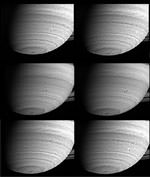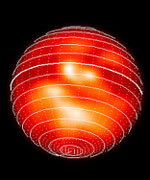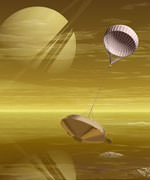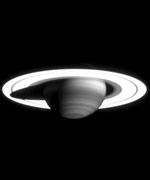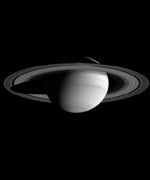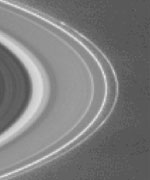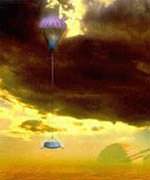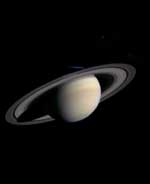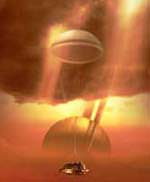
Image credit: ESA
It takes at least three elements to harbor life as we know it: water, energy and an atmosphere. Among Mars and the moons around both Jupiter and Saturn, there is evidence of one or two of these three elements, but less is known if a complete set is available. Only Saturn’s moon, Titan, has an atmosphere comparable to Earth’s in pressure, and is much thicker than the martian one (1% of Earth’s sea level pressure).
The most interesting point about simulations of Titan’s hydrocarbon haze is that this smoggy component contains molecules called tholins (from the Greek word, muddy) that can form the foundations of the building blocks of life. For example, amino acids, one of the building blocks of terrestrial life, form when these red-brown smog-like particles are placed in water. As Carl Sagan pointed out, Titan may be regarded as a broad parallel to the early terrestrial atmosphere with respect to its chemistry and in this way, it is certainly relevant to the origins of life.
This summer, NASA’s Cassini spacecraft, launched in 1997, is scheduled to go into orbit around Saturn and its moons for four years. In early 2005, the piggybacking Huygens probe is scheduled to plunge into the hazy Titan atmosphere and land on the moon’s surface. There are 12 instruments onboard the Cassini Spacecraft orbiter, and 6 instruments onboard the Huygens Probe. The Huygens probe is geared primarily towards sampling the atmosphere. The probe is equipped to take measurements and record images for up to a half an hour on the surface. But the probe has no legs, so when it sets down on Titan’s surface its orientation will be random. And its landing may not be by a site bearing organics. Images of where Cassini is in its current orbit are continuously updated and available for view as the mission progresses.
Astrobiology Magazine had an opportunity to talk with research scientist, Jean-Michel Bernard of the University of Paris, about how to simulate Titan’s complex chemistry in a terrestrial test tube. His simulations of Titan’s environment build on the classic prebiotic soup, first pioneered fifty years ago by University of Chicago researchers, Harold Urey and Stanley Miller.
Astrobiology Magazine (AM): What first stimulated your interest in the atmospheric chemistry of Titan?
Jean-Michel Bernard (JB): How do two simple molecules (nitrogen and methane) create a very complex chemistry? Does chemistry become biochemistry? The recent discoveries of life in extreme conditions on Earth (bacteria in the South Pole at -40?C and archaea at more than +110?C in the vicinity of hydrothermal sources) allow to suppose that life could be present on other worlds and other conditions.
Titan has astrobiological interest because it is the only satellite in the solar system with a dense atmosphere. Titan’s atmosphere is made of nitrogen and methane. The energetic particles coming from the Sun and Saturn’s environment allow complex chemistry, such as formation of hydrocarbons and nitriles. The particles also generate a permanent haze around the satellite, rains of methane, winds, seasons Recently, lakes of hydrocarbons seem to have been detected on Titan’s surface. I think that this discovery, if it is confirmed by the Cassini-Huygens mission, will be of great interest.
It would make Titan an analog to the Earth, since it would have an atmosphere (gas), lakes (liquid), haze and soil (solid), the three necessary environments for the appearance of life.
The composition of Titan’s haze is unknown. Only optical data are available and they are difficult to analyze due to the complexity of this carbonaceous material. Many experiments have been carried out in order to mimic the chemistry of Titan’s atmosphere, most notably the aerosols analogs named “tholins” by Carl Sagan’s group. It seems that tholins could be involved in the origin of life. Indeed, hydrolysis of these Titan aerosol analogs gives rise to the formation of amino acids, the precursors of life.
AM: Can you describe your experimental simulation for extending the Miller-Urey experiments in a way that is customized for Titan’s low temperatures and unique chemistry?
JB: Since the Miller-Urey experiments, many experimental simulations of supposed prebiotic system have been carried out. But after the retrieval of Voyager’s data, it appeared necessary to come back to this approach to simulate Titan’s atmosphere. Then several scientists carried out such simulation experiments by introducing a nitrogen-methane mixture in a system like Miller’s apparatus. But a problem became obvious due to the difference between the experimental conditions and Titan’s conditions. The pressure and temperature were not representative of Titan’s environment. Then we decided to carry out experiments which reproduce the pressure and the temperature of Titan’s stratosphere: a gas mixture of 2% of methane in nitrogen, a low pressure (about 1 mbar) and a cryogenic system in order to have a low temperature. Furthermore, our system is placed in a glove box containing pure nitrogen in order to avoid contamination by ambient air of the solid products.
AM: What do you consider the best energy source for triggering Titan’s synthetic chemistry: the magnetosphere of Saturnian particles, solar radiation, or something else?
JB: Scientists debate about what energy source would best simulate the energy sources in Titan’s atmosphere. Ultraviolet (UV) radiation? Cosmic rays? Electrons and other energetic particles coming from Saturn’s magnetosphere? All these sources are involved, but their occurence depends of the altitude: extreme ultraviolet radiation and electrons in the ionosphere, UV light in the stratosphere, while cosmic rays occur in the troposphere.
I think the appropriate question should be: What is the experimental goal? If it is to understand the hydrogen cyanide (HCN) chemistry in Titan’s stratosphere, a simulation with UV radiation of HCN is appropriate. If the goal is to determine the effects of electric fields generated by galactic cosmic rays in the troposphere, a corona discharge of a simulated Titan-atmosphere is preferable.
In studying Titan’s stratospheric conditions, we chose to use an electric discharge in our simulation. This choice is contested by a minority of scientists because the main energy source in Titan’s stratosphere is UV radiation. But our results validated our experiment. We detected all the organic species observed on Titan. We predicted the presence of CH3CN (acetonitrile) before its observation. We detected for the first time dicyanoacetylene, C4N2, an unstable molecule at room temperature that has also been detected in Titan’s atmosphere. The middle infrared signature of the solid products created in our experiment was in line with Titan observations.
AM: How are your results part of the planned atmospheric testing for the Cassini-Huygens probe?
JB: After collaborating with a team from the Observatoire Astronomique de Bordeaux in France, we determined the dielectric constants of aerosol analogs. This will allow us to estimate how Titan’s atmosphere and surface properties could affect the performance of the Cassini-Huygens radar experiments. The altimeter onboard the Huygens probe could be affected by the aerosol properties, but complementary experiments must be carried out to confirm this result.
Two years ago, we introduced a gas mixture, N2/CH4/CO (98/1.99/0.01). The goal was to determine the impact of carbon monoxide, the most abundant oxygenated compound on Titan. Surprisingly, we detected oxirane in the gaseous phase as the major oxygenated product. This unstable molecule was discovered in the interstellar medium but theoretical models do not predict it for Titan’s chemistry. Yet maybe this molecule is present on Titan.
Currently, we are analyzing the first molecules, radicals, atoms and ions (or ‘species’) created inside our experimental reactor. We are using infrared spectrometry and UV-visible emission to study excited species like CN, CH, NH, C2, HCN, C2H2. Next, we will observe the correlation between the abundance of these species and the structures of the solid products. . Coupling these experimental results with a theoretical model developed in collaboration with the University of Porto in Portugal, we will have a better understanding about the chemistry occurring into the experimental reactor. This will allow us to analyze the Cassini-Huygens data and Titan’s haze formation.
Our team is involved at the mission science level as well, as one of the scientists of the mission is also in our group at the Laboratoire Inter-Universitaire des Syst?mes Atmosph?riques, LISA). Our laboratory tholins will be used as guides to calibrate several of the instruments on the Huygens probe and the Cassini orbiter.
There are 18 instruments on board the probe and orbiter. Calibration tests are needed for gas chromatography and mass spectroscopy [GC-MS]. The GC-MS will identify and measure chemicals in Titan’s atmosphere.
Calibration tests are also needed for the Aerosol Collector and Pyrolyser (ACP). This experiment will draw in aerosol particles from the atmosphere through filters, then heat the trapped samples in ovens to vaporize volatiles and decompose the complex organic materials.
The Composite Infrared Spectrometer (CIRS), a thermal measuring instrument on the orbiter, also needs to be calibrated. Compared to previous deep space missions, the spectrometer onboard Cassini-Huygens is a significant improvement, with a spectral resolution ten times higher than the Voyager spacecraft’s spectrometer.
AM: Do you have future plans for this research?
JB: Our next step is an experiment developed by Marie-Claire Gazeau, called “SETUP”. The experiment has two parts: a cold plasma in order to dissociate nitrogen, and a photochemical reactor in order to photodissociate methane. This will give us a better global simulation of Titan’s condition.
Original Source: NASA Astrobiology Magazine
